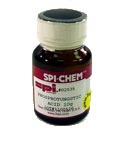SPI-Chem Phosphotungstic Acid, CAS 12501-23-4
| Chemical Formula: | H3PO4•12WO3•nH2O |
| CAS#: | 12501-23-4 |
| Formula Weight: | 2880.17 |
| RTECS #: | TH5650000 |
| Apperance: | Slightly efforescent, hyroscopic crystals in the form a powder |
| Color: | White or yellowish green |
| Odor: | None reported |
| Boiling Point: | Not available |
| Melting Point: | Not available |
| Specific Gravity (H2O = 1): | 3.2 |
Shipping Information
| UN #: | 3260 |
| Proper Shipping Name: | Corrosive solid, acidic, inorganic, n.o.s.. |
| Hazard Class: | 8 |
| Packing Group: | III |
PTA is a commonly used negative stain for viruses, polysaccharides, nerves, other biological issue material to be viewed by transmission electron microscopy. There have also been some so-far-as-we-know unpublished reports that PTA can be used for the staining of various nylons, a polymer apparently not readily stained by other electron dense stains. One major advantage of using PTA is that the pH can always be adjusted as desired. Some protocols also call for the use of PTA as a fixative.
For further information, see: Phosphotungstic Acid Staining of Polysaccharides Containing Structures on Epoxy Embedded Tissues, Bloom, E. E., And Aghajinian, G.K., J. Submicroscopic Cytology 11, 263 (1968).
PTA is a commonly used negative stain for viruses, polysaccharides, nerves, other biological issue material to be viewed by transmission electron microscopy. There have also been some so-far-as-we-know unpublished reports that PTA can be used for the staining of various nylons, a polymer apparently not readily stained by other electron dense stains. One major advantage of using PTA is that the pH can always be adjusted as desired. Some protocols also call for the use of PTA as a fixative.
For further information, see:
Phosphotungstic Acid Staining of Polysaccharides Containing Structures on Epoxy Embedded Tissues, Bloom, E. E., And Aghajinian, G.K., J. Submicroscopic Cytology 11, 263 (1968).



